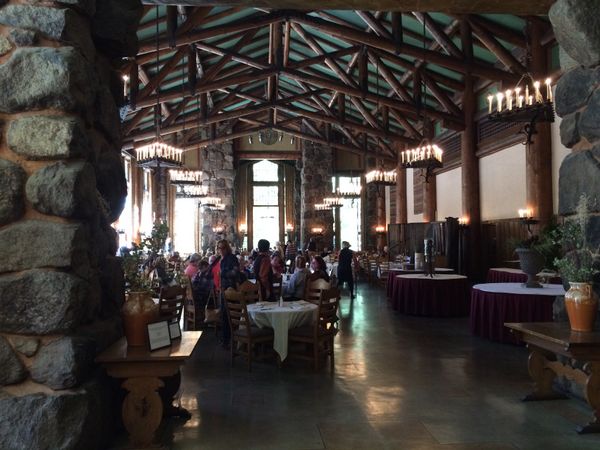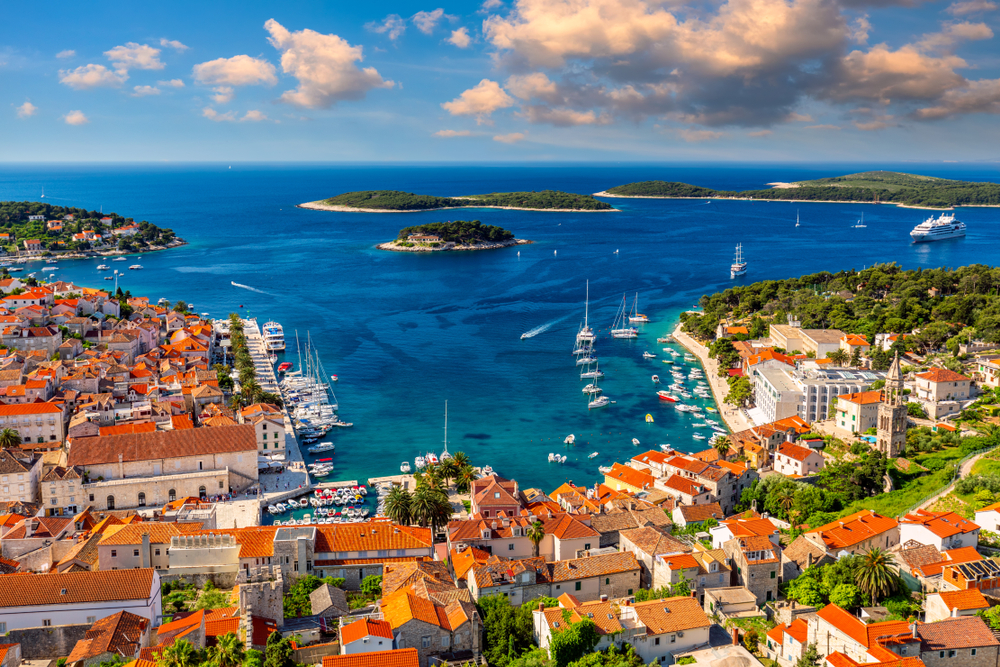National Parks Family Road Trip: Part 2 – Highlights of Yosemite
Signing up for credit cards through partner links earns us a commission. Terms apply to the offers listed on this page. Here’s our full advertising policy: How we make money.
Update: One or more card offers in this post are no longer available. Check our Hot Deals for the latest offers.
According to National Geographic, Yosemite is one of the top 5 most visited US National Parks, with ~4 million visitors each year. And for good reason!
Whether you want relax and take in the stunning scenery, or be adventurous and head out horseback riding, hiking, or rock climbing, there are endless things to see and do in the park.
Million Mile Secrets team member Meghan recently returned from a 2,500+ mile road trip through some of the top National Parks in the US. I’ll let her tell you about it!
Meghan: My husband and I love adventure, and with a new(ish!) baby in tow, we decided it would be a great idea to take a road trip to fantastic National Parks like Yosemite, Death Valley, Red Rock Canyon, Zion, and Bryce Canyon. Especially because our daughter is still light enough to carry in a backpack. 😉

I’ll share the highlights of our trip to Yosemite National Park. And tips for planning your own trip to this fantastic spot!
Visiting Yosemite National Park
Link: Yosemite National Park
Visiting Yosemite was the main reason for our family road trip, because my husband lived and worked in the park as a maintenance tech (read: climbing junkie ;)) for a few years, and always spoke of how amazing it was.
So I was extremely excited to get my own personal guided tour of the park!
Getting There
There are 4 entrances to Yosemite National Park: the Arch Rock Entrance (West), Tioga Pass Entrance (East), Big Oak Flat Entrance (Northwest), and South Entrance (South). And the Tiago Pass Entrance is closed during the winter months.
You can check this page for driving directions from nearby cities like Los Angeles, San Diego, and Las Vegas. That will help you plan your trip if you’re flying in from other parts of the US.

We drove in from the East side of the park, through Lee Vining and the Tioga Pass Entrance. If you pass through this entrance, be sure to stop at the notorious Tioga Gas Mart to stock up on snacks and Yosemite schwag. Or to eat a hearty meal from the Whoa Nellie Deli. Their french fries will hit the spot after a long hike!
Yosemite Lodging
1. Hotels
If you want a hotel room in Yosemite Valley, you only have 2 options: The Majestic Yosemite Valley Hotel and the Yosemite Valley Lodge.
Rooms at The Majestic Yosemite Valley Hotel (formerly known as the Ahwahnee Hotel) normally cost ~$407+ per night. And rooms at the Yosemite Valley Lodge run ~$267+ per night.

Because we planned our trip only ~2 months in advance, the only room left was a suite at The Majestic Yosemite Valley Hotel for ~$940 per night!
If you’re willing to rough it a bit, you could stay at Half Dome Village or Housekeeping Camp. Both spots offer canvas tents. Just note, not all of them are heated year around! There are even a few small cabins for rent in Half Dome Village.

Rates for the canvas tents are ~$80 to ~$170, depending on the time of year.
There’s also the Tuolumne Meadows Lodge, Big Trees Lodge, and White Wolf Lodge. But all of these are outside the Valley in different corners of the park. So depending on what you plan to do, they may or may not be a convenient home base. And these lodges are NOT open year-round.
2. Camping
There are a number of camping and RV sites, but they book up fast, so it’s important to make reservations online before you arrive. Otherwise you’ll have to wait in line VERY early in the morning to snag one of the limited first-come, first-served spots.
We were lucky to find 4 available nights at the Upper Pines campground in the Valley. We were happy to have a place to stay. But if I did it over again, I’d much prefer to camp somewhere outside of the Valley to avoid the crowds.
That said, if you decide to camp in the Valley, I’d suggest looking at a map and choosing a spot on the outer edge of the campground, so you aren’t surrounded by people (or RVs!).

Plus, not all of the campgrounds are open year-round, so check this site when you’re making plans.
Yosemite Hiking
Link: Yosemite National Park Map
Link: Yosemite Valley Map
I’ve included information on trails we hiked, that are some of the most popular in the park. And this site is a great resource for more information on day hikes around Yosemite!
1. Tuolumne Meadows
Cathedral Lakes
The Cathedral Lakes hike is one of the best hikes in the park because it takes you through alpine meadows and lakes, and offers great views of the 10,000-foot Cathedral Peak.
It’s an out-and-back hike that runs along a portion of the John Muir Trail.
We hiked to both Lower and Upper Cathedral Lake, and even adventured off-trail to the base of Cathedral Peak.

The trail is well marked, but remember, you’re hiking at ~8,500 feet, so you might not move as fast as you normally do. 😉
I can’t wait to go back and do the High Sierra Loop! The loop connects all the High Sierra Camps, so you don’t have to carry any camping gear or food.

Mono Pass
The Mono Pass hike is another fantastic option in Tuolumne Meadows.
It’s a nearly 8-mile out-and-back, where you’ll see beautiful streams, meadows, and endless views of the Sierra Mountains!
Again, you’ll end up at over 10,000 feet on this hike, so be careful if you have issues with altitude.
This was one of my favorite hikes in the park because we didn’t see anyone else along the trail!
2. Yosemite Falls Trail
If you’re visiting Yosemite in spring or early summer, you can get up close to Yosemite Falls at different points along the Yosemite Falls trail.
Because we visited the park in mid-October, there wasn’t much water running down the falls. But the hike was still beautiful!

3. Half Dome via The Mist Trail
Half Dome is one of the most iconic granite rock formations in Yosemite (the other being El Capitan), and the good news is, you can get to the top even if you’re not into rock climbing!
The trip to the peak is ~14 miles via the Mist Trail and parts of the trail include climbing with the help of cables, so it definitely isn’t the easiest hike in the park. But it’s one of the most rewarding!
Take note, you need a permit to hike Half Dome, so you’ll have to plan your trek in advance.
4. Panorama Trail
Most people arrange transportation to Glacier Point then hike the Panorama Trail downhill and end in the Valley.

It’s ~8.5 miles one-way, and you’ll get great views of lots of Yosemite Valley. Including Half Dome, North & Basket Domes, and the Royal Arches. So it’s a great hike for geology lovers!
And don’t forget, there are plenty of other activities in the park if hiking isn’t your thing. Like biking, horseback riding, cross-country skiing, and more.
Yosemite Dining
If you’re camping, be sure to stock up on supplies before you enter the park, because groceries inside the park are much more expensive.
Otherwise, you can check out the restaurants in each of the lodges.

We frequented the Pizza Deck in Half Dome Village because…PIZZA! But if you want a fancier experience, make reservations for dinner in The Majestic Yosemite Hotel’s dining room.
You Can Do It, Too!
Camping, Hotels, & Airbnb Stays
If you decide to camp during your vacation, be sure to bring enough cash. Because you can NOT pay with a credit card at a lot of camp sites, unless you’re booking your site in advance.
And if you want to use points for a hotel stay, you can use tools like Hotel Hustle and AwardMapper to help search for award nights along your route.
Just remember, it can be hard to find chain hotels inside most parks. So you’ll have to decide whether it’s worth staying outside the park and driving in each morning.
Or you could even find a great Airbnb nearby!
I like spending as much time exploring as I can during a vacation, so I’d prefer to pay cash for a hotel inside the park to save time, and save my points for another trip.
Gas
One of the biggest expenses on a road trip is gas. So use a credit card that earns miles, points, or cash back at gas stations.
I used my Chase Ink Plus (no longer available), that earns 2X Chase Ultimate Rewards on gas. But you could also use a card like the Premier Rewards Gold Card from American Express, that earns 2 AMEX Membership Rewards points per $1 you spend at US gas stations. Or the Blue Cash Preferred® Card from American Express that earns 3% cash back at US gas stations.
Check out this post about how to decide which is the best card to save on gasoline.
Flights & Rental Cars
Depending on where you live and which parks you plan to visit, you might need to fly closer to your destination and rent a car.
Using the Southwest Companion Pass can save you LOTS of money on airfare, because you can fly nearly 2-for-1 on domestic paid and award tickets.
Pay with a credit card that earns bonus miles and points on airlines. Or a card that earns a bonus on travel, like the Chase Sapphire Preferred Card or Barclaycard Arrival Plus World Elite Mastercard.
And if you need to rent a car, read this series on cheap car rentals, for tips & tricks on saving money on rental cars.
More Ways to Save Money
All of the National Parks charge a vehicle entrance fee, so depending on how many parks you plan to visit, it could be worth buying an Annual Pass that costs $80.
I did the math, and if you plan on visiting 2+ parks over the year, an annual pass is likely worth it. Because the major parks, like Yosemite and Grand Canyon National Park, charge $30 for a week-long permit. And the pass grants you access to other National Park Service monuments, like Devils Postpile, that can easily cost $10+ per visit.
Tip: This Wikipedia page lists the areas in the US National Park System. So it’s a good resource for planning your trip.
Plus, if you need to buy gear for your trip, you can go through shopping portals that earn cash back, miles, or points at certain retailers. I like using sites like CashbackMonitor.com that show you what bonuses various portals are offering.
And don’t forget to check out this post on how to plan a terrific road trip!
Bottom Line
Yosemite National Park should be on everyone’s “must see” list. There’s so much to see and do there! And the scenery is truly breathtaking.
In the next part of the series, I’ll share the highlights of our time in Death Valley & Red Rock Canyon!
Editorial Note: We're the Million Mile Secrets team. And we're proud of our content, opinions and analysis, and of our reader's comments. These haven’t been reviewed, approved or endorsed by any of the airlines, hotels, or credit card issuers which we often write about. And that’s just how we like it! :)






Join the Discussion!